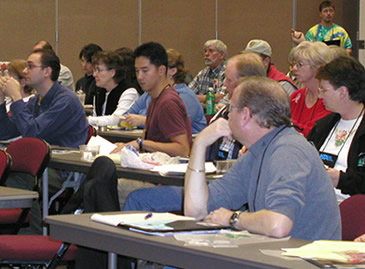 Science Topics for Students of Different Ages
Science Topics for Students of Different Ages
State and national content standards drive much of today’s classroom content.
The following list of topics for different grade levels was developed for researchers who study the atmospheric and related sciences as suggestions for ways to connect their branch of science to classrooms in ways that connect with relevant National Science Education Standards.
Grades K-4
- Energy: The Sun as a source of energy. (Perhaps looking at light & heat)
- Weather & Climate: Observe the weather and weather patterns (check out our Watch the Sky activity). Distinguish between weather and climate. Try hands on activities such as Make a Tornado or Cloud in a Bottle.
- Astronomy & Space Science
- Locating the Sun and Moon.
- Observe the Sun (safely) and shadows. Measure changes in position and length of shadows.
- Share a pictorial tour of the Solar system
- Discuss and draw pictures of the Earth from space (See our Earth Image Gallery for examples)
- Make observations of the Moon
- Observation, Description, & Classification:
- Use the five senses to observe, describe, measure, & classify various objects.
- Compare and contrast the characteristics of living and non-living things, for example a guinea pig, a flower, and a rock.
- Discuss why and how scientists classify objects.
- Present images of various objects classified by scientists, for example galaxies, stars
- Models & Scale: explore student understanding of models, their use and importance, make a scale model of a planet
- Read a story with a science theme. Examples: Keepers of the Earth, There’s No Place Like Space, Connie & Bonnie’s Birthday Blastoff
Grades 5-8
- Chemistry
- Investigate/introduce the structure of matter. Compare solids, liquids, gases, and plasma. Discuss and explore volume, mass, and density. (Try the Exploring Density of Salt and Fresh Water activity.)
- Explore, model, and discuss the structure of atoms, and chemical bonds. (Try the Tetrahedron activity.). Show the effects of changing pressure and/or temperature.
- Physics: Explore light, shadows, reflecting light, color, wavelegths beyond visible light, make and use a spectroscope or photometer. (Try the Spectral Suprise activity).
- Weather & Climate: Observe the weather and weather patterns. (Try the Watch the Sky activity). Distinguish between weather and climate. Try hands on activities such as Make a Tornado or Cloud in a Bottle.
- Astronomy & Space Science
- Observe the Sun, its structure, sunspots, space weather, and solar variability. (Try the Terrabagga or Plotting Sunspots activities)
- Explore apparent and actual movement of the Earth. Model “spin” versus “orbit”.
- Explore time and concepts of time with respect to astronomical definitions. Make a simple clock: sundial, water clock, or sand clock.
- Systems & Cycles: Explore various Earth systems and cycles (Try the Traveling Nitrogen game or Carbon Dioxide Sources and Sinks)
- Observation, Description, & Classification
- Present images of various objects classified by scientists; have students group images .
- Introduce and use tools that expand our powers of observation such as microscopes and telescopes.
- Science & Technology: Introduce and explore robotics, satellites, and other important technologies that support research.
- Models & Scale: Explore student understanding of models & scale, their use and importance (make a model of a planet)
- Data Collection & Interpretation: help students practice data interpretation and graphing using data sets.
- Careers
- Discuss and describe various careers in science, mathematics, and engineering. Provide a broad overview.
- Discuss, describe, and model the research process, teamwork, and the importance of personal effort and leadership.
Grades 9-12
- Chemistry
- Investigate/introduce the structure of matter. Compare solids, liquids, gases, and plasma. Discuss and explore volume, mass, and density.
- Explore, model, and discuss the structure of atoms, chemical bonds, the effects of changing pressure and/or temperature.
- Physics
- Explore the properties of light: light and shadows, reflecting light, color, beyond visible light, make a spectroscope or photometer.
- Use the photometer to investigate magnitude and distance.
- Weather & Climate
- Have students calculate their contribution to GHG using on-line or other calculators available.
- Discuss energy use, conservation, resources and land planning
- Astronomy & Space Science
- Present, discuss, and model stellar evolution.
- Use mathematics to calculate the height of a distant object.
- Examine the Sun, space weather and solar variability.
- Systems & Cycles: Explore the human impact on various Earth systems and cycles:
- Observation, Description, & Classification: Introduce and use tools that expand our powers of observation: microscopes, telescopes…
- Science & Technology: Introduce and explore robotics, satellites, and other important technologies that support research.
- Models & Scale: Identify complex models that students may encounter, have students practice modeling abstract ideas using mathematics.
- Data Collection & Interpretation: Identify interesting and appropriate graphs or data sets. Use these to help students practice data interpretation, graphing, and discussing the results.
- Careers
- Discuss and describe various careers in science, mathematics, and engineering. Provide a broad overview.
- Discuss, describe, and model the research process, teamwork, and the
importance of personal effort and leadership.
Resources:
- Scientists in Schools Home
- About Scientists in Schools
- Getting to Know a School
- Definitions of Common Educational Terms
- Checklist for a School Visit
- Working with K-12 Students
- Science Topics for Students of Different Ages
- Making a Lesson Plan
- Recommended Resources









